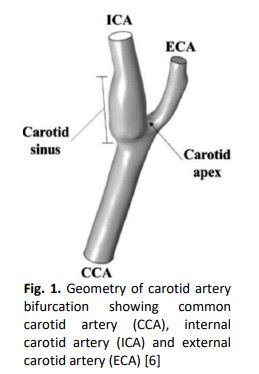Blood Flow Acoustics in Carotid Artery
DOI:
https://doi.org/10.37934/arfmts.94.1.2844Keywords:
Computational Fluid Dynamics (CFD), Stenosis, Carotid Artery, Bifurcation, Blood flowAbstract
This paper aims to identify and study the blood flow and acoustics characteristics of different degrees of stenosis in the carotid artery. Blood flow will produce acoustics, but the presence of different levels of stenosis are expected to produce different acoustic characteristics. The blood flow and acoustic characteristics are simulated by using computational fluid dynamics software (CFD). Several three-dimensional models of carotid arteries that have different degrees of stenosis are used together with a normal/healthy carotid artery - i.e., 30% and 70% degrees of blockage. The geometry of 30% and 70% stenosed model are computationally generated from a normal carotid artery geometry. In addition, the blood viscosity level was also increased in this study to a value of 0.005 kgms-1 (from the normal viscosity of 0.004 kgms-1) to compare the effect of hyperglycaemia (i.e., diabetes mellitus) that may bring additional complications to blood flow. Pulsatile simulations are used for all cases in order to mimic the exact blood flow condition in which the inlet velocity and outlet pressure change with time. The present study shows that as the degree of stenosis increases at the common carotid artery (CCA), the velocity at the internal carotid artery (ICA) and external carotid artery (ECA) outlet increases. The maximum velocity changes for ICA at the systolic peak from normal to 70% degree of stenosis for carotid artery shows an increase by 8%, while an opposite trend is observed for the maximum velocity changes of ECA at the systolic peak, where a reduction by 3% occurs from normal to 70% degree of stenosis for carotid artery. In terms of viscosity, as the viscosity of the blood increases, the velocity of the blood flow decreases in all geometry carotid arteries and may potentially provide further complications on clinical problems. The acoustic simulation showed that the acoustic power increases by 5% and 20% for carotid artery geometry that has 30% and 70% degree of stenosis, respectively. The present study indicates potential for further developing non-invasive acoustic means to diagnose and measure stenosis in carotid arteries.
Downloads

































